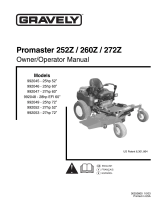
GB-8
DO NOT operate at too fast a rate. DO NOT change engine
governor settings or over-speed engine. Slow down and turn
corners slowly.
Disengage PTO when attachment is not in use. DO NOT
raise deck with blades running. ALWAYS turn off power to
attachment when travelling, crossing driveways, etc.
Avoid uneven and rough terrain. DO NOT operate near
drop-offs, ditches, or embankments. Unit can suddenly turn
over if a wheel is over the edge of a cliff or ditch, or if an
edge caves in.
DO NOT try to stabilize unit by putting foot on ground when
operating with applicable riding attachments.
When engine is running and speed control lever is forward,
holding only one steering lever will cause unit to circle
around one drive wheel.
Use care when approaching blind corners, shrubs, trees or
other objects that may obscure view.
ALWAYS disengage PTO, stop unit and engine, remove key
and allow moving parts to stop before clearing clogs or
cleaning unit.
Never leave a running unit unattended. ALWAYS shut off
engine before leaving unit.
ALWAYS remove key to prevent unauthorized use.
DO NOT operate in reverse unless absolutely necessary.
ALWAYS backup slowly. ALWAYS look down and behind,
before and while backing.
DO NOT operate on steep slopes. DO NOT operate on
slopes of more than 10°. Operate across the face of slopes,
not up and down.
Turf conditions can affect the unit’s stability.
Keep all movement on slopes slow and gradual. DO NOT
make sudden changes in speed or direction. Use a slow
speed to avoid stopping or shifting on slopes. Avoid starting
or stopping on a slope.
DO NOT park unit on a slope unless absolutely necessary.
When parking on a slope always chock or block wheels.
Use extra care when loading or unloading unit onto trailer or
truck.
Secure unit chassis to transport vehicle. NEVER secure
from rods or linkages that could be damaged.
DO NOT transport machine while engine is running.
Keep unit free of grass, leaves, or other debris. Clean up oil
or fuel spills.
This product is equipped with an internal combustion engine.
DO NOT use on or near any unimproved, forest covered or
brush covered land unless the exhaust system is equipped
with a spark arrester meeting applicable local, state or
federal laws. A spark arrester, if used, must be maintained in
effective working order by the operator.
Fuel is highly flammable and its vapors are explosive.
Handle with care. Use an approved fuel container.
No smoking, No sparks, No flames. ALWAYS allow engine to
cool before servicing.
NEVER fill fuel tank when engine is running or hot from
operation.
NEVER fill or drain fuel tank indoors.
Replace fuel cap securely and clean up spilled fuel.
Never fill containers inside a vehicle or on a truck or trailer
bed with a plastic liner. Always place containers on the
ground away from your vehicle before filling.
When practical, remove gas-powered equipment from the
truck or trailer and refuel it on the ground. If this is not
possible, then refuel such equipment on a trailer with a
portable container, rather than from a gasoline dispenser
nozzle.
Keep the nozzle in contact with the rim of the fuel tank or
container opening at all times until fueling is complete. Do
not use a nozzle lock-open device.
If fuel is spilled on clothing, change clothing immediately.
NEVER store fuel inside where there is an open flame, such
as a water heater.
Before making any inspections, repairs, etc.: disengage
PTO, stop unit and engine, remove key, allow moving parts
to stop.
Allow hot parts to cool.
ALWAYS block wheels, engage parking brake and know all
jack stands are strong, secure and will hold weight of unit
during maintenance.
An extension spring, when extended, stores energy and can
be dangerous. Always use tools specifically designed for
installing or removing an extension spring. Always compress
or extend springs slowly.
ALWAYS maintain unit in safe operating condition. Damaged
or worn out muffler can cause fire or explosion.
Keep hardware, especially blade attachment bolts, tight.
Maintain or replace safety and instruction labels, as
necessary.
For unit storage or extended storage:
• NEVER store with fuel in fuel tank, inside a building
where any ignition sources are present.
• Allow engine to cool completely.
Use only attachments or accessories designed for your unit
and that can be used safely on your terrain.
Check attachment components frequently for wear, damage
or deterioration. Replace with manufacturer’s recommended
parts for safety.
To reduce fire hazard and overheating, keep equipment free
of grass, leaves, debris or excessive lubricants.
Use extra care with grass catchers and other attachments.
These can change the stability of the unit. Use only
approved hitch points.
ALWAYS be aware of attachments when turning. ALWAYS
allow adequate clearance between attachments, personnel,
and other objects.





















